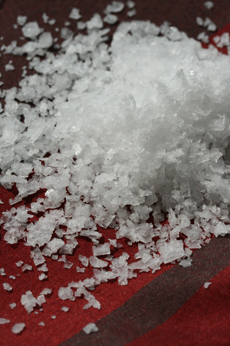TIP: It’s Time To Consider Less Salt
 Anglesey salt, sold here under the brand name Halen Mon, is evaporated from Welsh sea water. Note that the crystals are square, not round. Photo by River Soma | THE NIBBLE |
What’s the deal with salt, and why is the government trying to limit it in prepared foods? Everyone needs to eat a certain amount of salt. The body doesn’t produce sodium (salt), but it requires it in order to perform a variety of essential functions. Salt helps to maintain the fluid in blood cells and is used to transmit information in nerves and muscles, among other functions. HOW MUCH SALT IS TOO MUCH? The American Heart Association recommends no more than 2,400 milligrams of sodium (salt) per day. That’s one single teaspoon. But the average American’s salt intake is more than twice that: 3,436 milligrams (mg) of sodium daily. Here’s more information from the USDA. Whatever the source, nine out of 10 Americans eat too much salt, according to The Centers for Disease Control. |
|
|
Starting today, the World Action on Salt and Health (WASH) is sponsoring its sixth annual Salt Awareness Week to gain worldwide recognition of the health risks associated with consuming too much salt. So today’s tip involves awareness and action. A diet that contains more than that one teaspoon of salt per day is associated with high blood pressure, a potentially fatal condition that affects one in four Americans. While other factors, such as age, family history and race, play a role in your risk of high blood pressure, lowering your sodium intake can help significantly reduce the risk. The more salt you eat, the higher your blood pressure will be, leading to heart disease, kidney disease and stroke. According to Consensus Action for Salt and Health, high blood pressure is the leading global risk factor for mortality, resulting in seven million deaths per year. |
||
|
WHAT CAN YOU DO ABOUT IT?
Thanks to LoSalt, a leading reduced sodium salt, for these tips. |
 It’s not the salt you can see, it’s the salt you can’t see, hidden in purchased foods (prepared foods, packaged foods, restaurant meals). Photo courtesy David Burke Fromagerie. |
|
|
TIP: WHEN USING LOTS OF SALT IN THE KITCHEN IS A GOOD IDEA Salt can be used to extinguish a grease fire. Pour salt on the flames; never use water. We keep a large salt server with kosher salt on our stove to add pinches in cooking, but also to help in a crisis. (Yes, we also have a fire extinguisher.) ABOUT LOSALT LoSalt, a tasty alternative in the reduced-sodium category, has 66% less sodium than regular salt. This is achieved by using a ratio of 33% sodium chloride and 66% potassium chloride. As long as you don’t need to avoid extra high levels of potassium (e.g. endocrine or kidney disorders), this natural ingredient is a good filler. Consult with your healthcare advisor to be sure it’s O.K. for you. |
||